Chapter 8
Keeping Your Life Organized
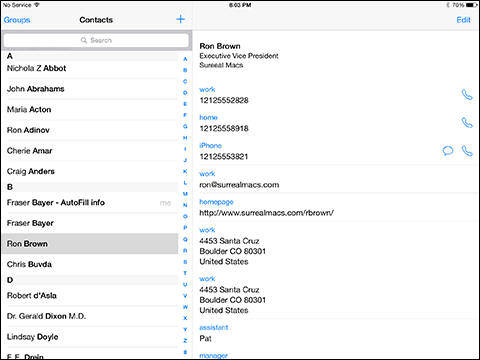
Your iPad comes with the Contacts app for managing your contacts, the Calendars app for organizing your schedule, the Reminders app for tracking tasks, the Maps app for directions, and the Clock app for timekeeping.
Share Contacts via E-Mail and Messages
Browse Existing Events in Your Calendars
Create New Events in Your Calendars
Work with Calendar Invitations
Track Your Commitments with Reminders
Find Your Location with the Maps App
Find Directions with the Maps App
Using the Maps App’s Favorites and Contacts
Browse or Search for Contacts
The Contacts app gives you easy access to the contacts you have added to your iPad by either syncing from your computer or an online service, such as iCloud, or by creating the contact records directly on the iPad. To see which contacts your iPad contains, or to find a particular contact, you can browse through the contacts.
You can either browse through your full list of contacts or choose to display only particular groups — for example, you can display only your business-related contacts by selecting the appropriate group. You can also locate contacts by searching for them.
Browse or Search for Contacts
Browse Your Contacts
![]() Press the Home button.
Press the Home button.
The Home screen appears.

![]() Tap Contacts.
Tap Contacts.
To navigate the screen of contacts quickly, tap the letter on the left that you want to jump to. To navigate more slowly, scroll up or down.

![]() Tap the contact whose information you want to view.
Tap the contact whose information you want to view.
The contact’s details appear.
![]() If necessary, tap and drag up to scroll down the screen to display more information.
If necessary, tap and drag up to scroll down the screen to display more information.
Choose Which Groups of Contacts to Display
![]() From the Contacts list, tap Groups.
From the Contacts list, tap Groups.
The Groups screen appears.

![]() Tap Show All Contacts.
Tap Show All Contacts.
Contacts displays a check mark next to each group.
Note: When you tap Show All Contacts, the Hide All Contacts button appears in place of the Show All Contacts button. You can tap Hide All Contacts to remove all the check marks.
![]() Tap a group to remove its existing check mark or apply a check mark.
Tap a group to remove its existing check mark or apply a check mark.
![]() Tap Done.
Tap Done.
The Contacts list appears, showing the contacts in the groups you selected.
Search for Contacts

![]() In the Contacts list, tap Search.
In the Contacts list, tap Search.
The Search screen appears.
![]() In the Search box, type the name you want to search for.
In the Search box, type the name you want to search for.
![]() From the list of matches, tap the contact you want to view.
From the list of matches, tap the contact you want to view.
The contact’s information appears.
Create a New Contact
Normally, you put contacts on your iPad by syncing them from existing records on your computer or on an online service such as iCloud. But when necessary, you can create a new contact directly on your iPad — for example, when you meet someone you want to remember.
You can then sync the contact record back to your computer, adding the new contact to your existing contacts.
Create a New Contact
![]() Press the Home button.
Press the Home button.
The Home screen appears.
![]() Tap Contacts.
Tap Contacts.
The Contacts list appears.
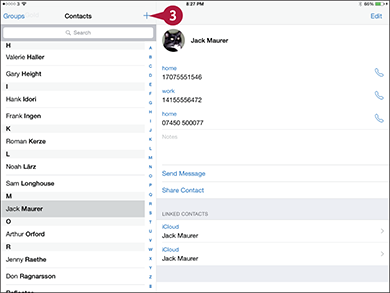
![]() Tap Add (
Tap Add (![]() ).
).
The New Contact screen appears, with the on-screen keyboard displayed.
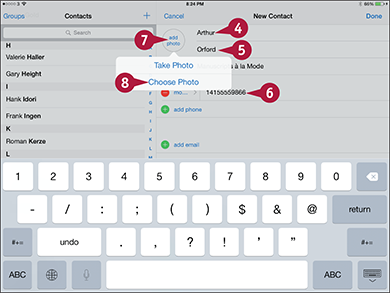
![]() Type the first name.
Type the first name.
![]() Type the last name.
Type the last name.
![]() Add other information as needed by tapping each field and then typing the information.
Add other information as needed by tapping each field and then typing the information.
![]() To add a photo of the contact, tap add photo.
To add a photo of the contact, tap add photo.
The Photo dialog opens.
![]() To use an existing photo, tap Choose Photo and follow this example. To take a new photo, tap Take Photo and see the tip.
To use an existing photo, tap Choose Photo and follow this example. To take a new photo, tap Take Photo and see the tip.
The Photos dialog opens.
![]() Tap the album that contains the photo you want to use.
Tap the album that contains the photo you want to use.
The album’s contents appear.
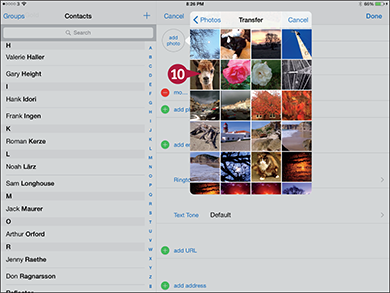
![]() Tap the appropriate photo.
Tap the appropriate photo.
The Move and Scale screen appears.

![]() Position the part of the photo you want to use in the middle.
Position the part of the photo you want to use in the middle.
Note: Pinch in with two fingers to zoom the photo out. Pinch out with two fingers to zoom the photo in.
![]() Tap Choose.
Tap Choose.
The photo appears in the contact record.
![]() Tap Done when you finish editing the contact record.
Tap Done when you finish editing the contact record.
The contact appears in your Contacts list.
Share Contacts via E-Mail and Messages
Often in business or your personal life, you will need to share your contacts with other people. Your iPad makes it easy to share a contact record either via e-mail or via Messages, the instant-messaging service offered by Apple.
The iPad shares the contact record as a virtual business card in the widely used vCard format. Most phones and personal-organizer software can easily import vCard files.
Share Contacts via E-Mail and Messages
Open the Contact You Want to Share
![]() Press the Home button.
Press the Home button.
The Home screen appears.

![]() Tap Contacts.
Tap Contacts.

![]() Tap the contact you want to share.
Tap the contact you want to share.
The contact’s details appear.
![]() Tap Share Contact.
Tap Share Contact.
The Share Contact Using dialog opens.
Share a Contact via E-Mail
![]() In the Share Contact Using dialog, tap Mail.
In the Share Contact Using dialog, tap Mail.

A A new message titled Contact appears in the Mail app, with the contact record attached as a vCard file.
![]() Address the message by typing the address or by tapping and choosing a contact as the recipient.
Address the message by typing the address or by tapping and choosing a contact as the recipient.
![]() Edit the default subject line if necessary.
Edit the default subject line if necessary.
![]() Type a message.
Type a message.
![]() Tap Send to send the message.
Tap Send to send the message.
![]() In the Share Contact Using dialog, tap Message.
In the Share Contact Using dialog, tap Message.

B The New Message screen appears, with the contact record attached to the message.
![]() Address the message by typing the name or number or by tapping and choosing a contact as the recipient.
Address the message by typing the name or number or by tapping and choosing a contact as the recipient.
![]() Type a message.
Type a message.
![]() Tap Send to send the message.
Tap Send to send the message.
Browse Existing Events in Your Calendars
Your iPad Calendar app gives you a great way of managing your schedule and making sure you never miss an appointment.
After setting up your calendars to sync using iTunes, iCloud, or another calendar service, as described in Chapter 1, you can take your calendars with you everywhere and consult them whenever you need to. You can view all your calendars or only the ones you choose.
Browse Existing Events in Your Calendars
![]() Press the Home button.
Press the Home button.
The Home screen appears.
![]() Tap Calendar.
Tap Calendar.
The Calendar screen appears.
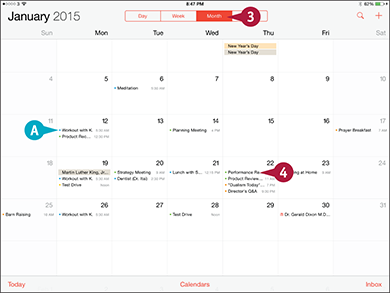
![]() Tap Month to see Month view, in which each day appears in a box on a calendar chart.
Tap Month to see Month view, in which each day appears in a box on a calendar chart.
A Month view shows a one-line entry with the time of each event that will fit in the box.
![]() Tap an event.
Tap an event.
A dialog opens, showing the event’s details.

B You can tap Edit to open the event so you can change its details.
Note: You can drag up and down to change the month that appears.
![]() Tap outside the dialog to close it.
Tap outside the dialog to close it.
![]() Tap Week.
Tap Week.
The Calendar switches to Week view.

C Your appointments appear on a grid that shows the days as columns and the hours as rows.
Note: In Week view, you can scroll left, right, up, or down to change the days and hours shown.
Note: In Week view and Day view, you can move an event by tapping and holding it until its color darkens, and then dragging it to where you want it.
![]() Tap Day.
Tap Day.
The Calendar switches to Day view.

D You can tap another day to display that day.
E The left pane shows a vertical timeline for the day.
F The right pane shows the details of the selected appointment.
G You can tap Edit to edit the appointment.
![]() Tap Today.
Tap Today.
Calendar displays the events for the current day.
Create New Events in Your Calendars
Normally, you will probably create most new events in your calendars on your computer, and then sync them to your iPad. But when you need to create a new event using the iPad, you can easily do so.
You can create either a straightforward, one-shot appointment or an appointment that repeats on a schedule. And you can choose which calendar the appointment belongs to.
Create New Events in Your Calendars
![]() Tap Calendar.
Tap Calendar.
![]() In Calendar, tap Week to switch to Week view.
In Calendar, tap Week to switch to Week view.
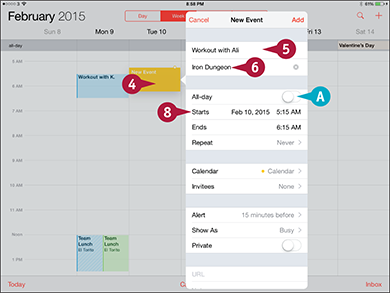
![]() Tap and hold the appropriate time slot.
Tap and hold the appropriate time slot.
The New Event dialog opens.
![]() Type the title of the event.
Type the title of the event.
![]() Tap Location.
Tap Location.
The Location dialog opens.
![]() Type or tap the location of the event.
Type or tap the location of the event.
The location appears.
A For an all-day appointment, set the All-day switch to On (![]() ).
).
![]() Tap Starts.
Tap Starts.

![]() Drag the date and time controls to set the start time.
Drag the date and time controls to set the start time.
![]() Tap Ends.
Tap Ends.
![]() Set the end time.
Set the end time.
B If you need to change the time zone, tap Time Zone, type the city name, and then tap the time zone.
![]() Tap Alert.
Tap Alert.
The Event Alert dialog opens.

![]() Tap the timing for the alert — for example, 30 minutes before.
Tap the timing for the alert — for example, 30 minutes before.
The Add Event dialog reappears.
Note: You can assign a second alert to the event by tapping Second Alert after choosing the first alert. A second alert can be a useful safety net for appointments you must not miss.
![]() Tap Calendar.
Tap Calendar.

![]() Tap the calendar to which you want to assign the event.
Tap the calendar to which you want to assign the event.
The Add Event dialog reappears.
![]() Tap Done.
Tap Done.
The event appears on your calendar.
Work with Calendar Invitations
Most likely, you will receive invitations to events that others create. When you receive an event invitation attached to an e-mail message, you can choose whether to accept the invitation or decline it. If you accept the invitation, you can add the event automatically to a calendar of your choice and set an alert for it.
Work with Calendar Invitations
Respond to an Invitation from an Alert

![]() When an invitation alert appears, tap Options.
When an invitation alert appears, tap Options.
Note: To control whether you receive alerts for invitations, press the Home button, and then tap Settings. In the Settings app, tap Notification Center, and then tap Calendar. Tap Invitations to display the Invitations screen. In the Alert Style When Unlocked area, tap Alerts to receive alerts in dialogs or tap Banners to display banners instead.
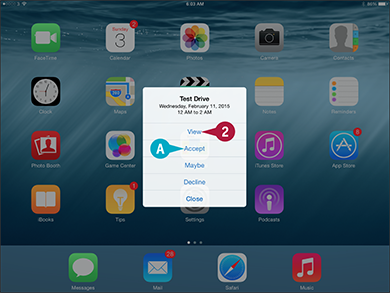
![]() Tap View.
Tap View.
A You can also tap Accept to accept the invitation, Decline to turn it down, or Maybe to accept tentatively.
The Calendar app appears.

B The event appears on the calendar.
The dialog for the event opens automatically.
C You can tap Calendar and choose the calendar to which you want to add the event.
D You can tap Alert and use the Event Alert dialog to set the alert time you want — for example, tap 30 minutes before.
![]() Tap Accept, Maybe, or Decline to give your response.
Tap Accept, Maybe, or Decline to give your response.
Respond to an Invitation from the Inbox
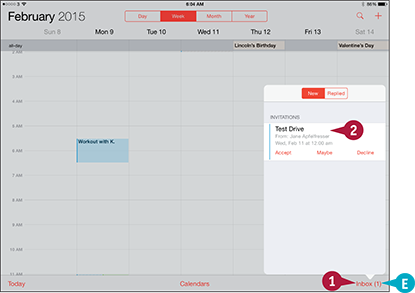
E In your calendar, the Inbox button shows the number of invitations.
![]() Tap Inbox.
Tap Inbox.
The Inbox dialog opens.
![]() To respond to an invitation immediately, tap Accept, Maybe, or Decline, as needed.
To respond to an invitation immediately, tap Accept, Maybe, or Decline, as needed.
Note: To see the details of an invitation, tap its button in the Inbox dialog. A dialog with the invitation’s details opens. From this dialog, you can accept the invitation, decline it, or return a “maybe.”
Track Your Commitments with Reminders
The Reminders app gives you an easy way to note and track your commitments. Reminders comes with a built-in list called Reminders, but you can create as many other lists as you need — for example, Errands, Shopping, or Household. You can create a reminder with no due time. Alternatively, you can tie each reminder to a due time, arriving at or leaving a location, or both, and have your iPad remind you of each reminder at the appropriate time or place.
Track Your Commitments with Reminders
Open the Reminders App
![]() Press the Home button.
Press the Home button.
The Home screen appears.
![]() Tap Reminders.
Tap Reminders.
The Reminders screen appears.
Note: When you complete a task, tap to the left of the reminder (![]() changes to
changes to ![]() ). If you need to reinstate the task, tap (
). If you need to reinstate the task, tap (![]() changes to
changes to ![]() ).
).

![]() In the Reminders app, tap the first blank line below the last reminder in the list.
In the Reminders app, tap the first blank line below the last reminder in the list.
Reminder starts a new reminder and displays the on-screen keyboard.

![]() Type the text of the reminder.
Type the text of the reminder.
A If you do not want to set any further details for the reminder, tap Done.
![]() Tap
Tap ![]() .
.
Note: To create a reminder using Siri, press the Home button for a couple of seconds until Siri beeps, and then say the reminder aloud. For example, say “Remind me at 8AM tomorrow to take the project files to the office.”
The Details dialog opens.
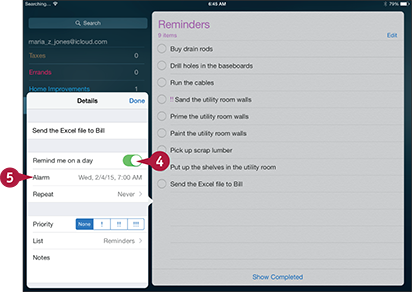
![]() Set the Remind me on a day switch to On (
Set the Remind me on a day switch to On (![]() ).
).
The Alarm button appears.
![]() Tap Alarm.
Tap Alarm.
Date and time controls appear.
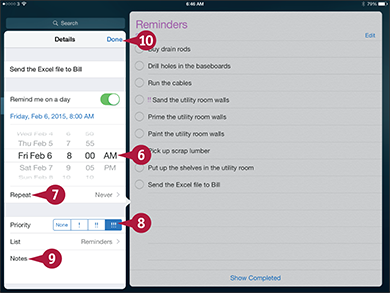
![]() Select the date and time for the reminder.
Select the date and time for the reminder.
![]() If you need to create a repeating reminder, tap Repeat and choose the repeat schedule in the Repeat dialog. For example, touch Every Day or Every Week.
If you need to create a repeating reminder, tap Repeat and choose the repeat schedule in the Repeat dialog. For example, touch Every Day or Every Week.
![]() To assign a priority, tap !, !!, or !!!. To remove the priority, tap None.
To assign a priority, tap !, !!, or !!!. To remove the priority, tap None.
![]() To add notes, tap Notes and type the text.
To add notes, tap Notes and type the text.
![]() Tap Done.
Tap Done.
The Details dialog closes.
Track Your Commitments with Reminders (continued)
You can organize your reminders into different lists so that you can look at a single category of reminders at a time. For example, you may find it useful to create a Work list that enables you to focus on your work-related reminders.
After creating lists, you can easily switch among them. You can also move a reminder from one list to another as needed. And when you no longer need a particular reminder, you can delete it.
Track Your Commitments with Reminders (continued)
Create Different Lists of Reminders
![]() On the Reminders screen, tap Add List.
On the Reminders screen, tap Add List.
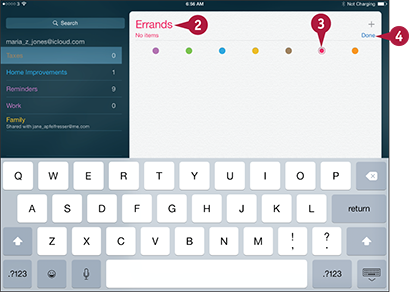
![]() Type the name for the new list.
Type the name for the new list.
![]() Tap the color button for the list.
Tap the color button for the list.
![]() Tap Done.
Tap Done.
Reminders adds the new list.
Note: To delete a Reminders list quickly, tap it in the lists pane and swipe left; then tap Delete and tap Delete again in the confirmation dialog. Alternatively, tap Edit at the bottom of the lists pane, tap Delete, and then tap Delete again.
Note: Deleting a Reminders list also deletes all the reminders it contains.
Switch Among Your Reminders Lists
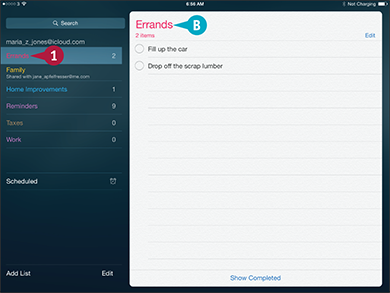
![]() On the Reminders screen, tap the list you want to display.
On the Reminders screen, tap the list you want to display.
B The list appears.
Change the List to Which a Reminder Is Assigned

![]() In a Reminders list, tap the reminder.
In a Reminders list, tap the reminder.
The ![]() button appears.
button appears.
![]() Tap
Tap ![]() .
.
The Details dialog opens.
![]() Tap List.
Tap List.
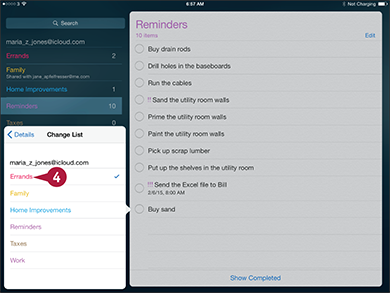
![]() Tap the list to which you want to assign the reminder.
Tap the list to which you want to assign the reminder.
The Details dialog opens.
![]() Tap Done.
Tap Done.
The Details dialog closes.
The reminder moves to the list you chose.
Note: You can delete a reminder by tapping Edit on its list page, tapping next to the reminder, and then tapping Delete. Alternatively, tap the reminder in its list, swipe left, and then tap Delete.
Find Your Location with the Maps App
The Maps app can pinpoint your location by using known wireless networks or — on cellular iPads — by using GPS (Global Positioning System) satellites or cellular towers. You can view your location on a road map, a satellite picture, or a hybrid that shows street annotations on the satellite picture. You can easily switch among map types to find the most useful one for your current needs. To help you get your bearings, the Tracking feature in the Maps app can show you which direction you are facing.
Find Your Location with the Maps App
The Home screen appears.
![]() Tap Maps.
Tap Maps.
The Maps screen appears.

A A blue dot shows your current location. The expanding circle around the blue dot shows that Maps is determining your location.
Note: It may take a minute for Maps to work out your location accurately. While Maps determines the location, the blue dot moves, even though the iPad remains stationary.
![]() Tap and pinch in with two fingers.
Tap and pinch in with two fingers.
Note: You can tap and pinch out with two fingers to zoom in.
The map zooms out, showing a larger area.
![]() Tap
Tap ![]() .
.
The Map Options dialog opens.

![]() Tap Satellite.
Tap Satellite.
The Satellite view appears.

![]() Tap Hybrid.
Tap Hybrid.
![]() Tap outside the Map Options dialog.
Tap outside the Map Options dialog.
Road names and places names appear overlaid on the satellite map.

![]() Tap Location (
Tap Location (![]() changes to
changes to ![]() ) to turn on the Location service.
) to turn on the Location service.
![]() Tap Location (
Tap Location (![]() changes to
changes to ![]() ).
).
B The Compass arrow appears (![]() ). The red arrow indicates north.
). The red arrow indicates north.
C The map turns to show the direction the iPad is facing, so that you can orient yourself.
Find Directions with the Maps App
The Maps app on your iPad can give you directions to where you want to go. Maps can also show you current traffic congestion to help you identify the most viable route for a journey.
Maps displays driving directions by default, but you can also display walking directions.
Find Directions with the Maps App
![]() Tap Maps.
Tap Maps.

![]() Tap Directions.
Tap Directions.
![]() Tap Start, and type the start location for the directions.
Tap Start, and type the start location for the directions.
Note: If the starting location or ending location is an address in the Contacts app, start typing the name, and then tap the match in the list.
![]() Type the end location.
Type the end location.
A You can tap Switch Places (![]() ) to switch the start location and end location.
) to switch the start location and end location.
![]() Tap Route.
Tap Route.
Maps displays the driving routes.
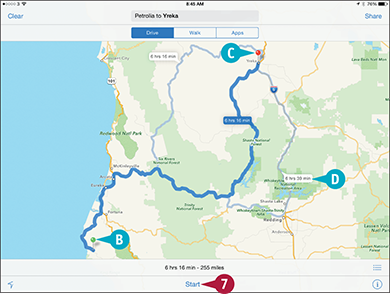
B The green pin marks the start.
C The red pin marks the end.
D You can tap a time button to view a different route. The time button changes to blue to indicate it is active.
![]() Tap Start.
Tap Start.
The first screen of directions appears.

![]() Tap and scroll as needed to follow the directions.
Tap and scroll as needed to follow the directions.
![]() If you want to see the full list of directions, tap Overview.
If you want to see the full list of directions, tap Overview.
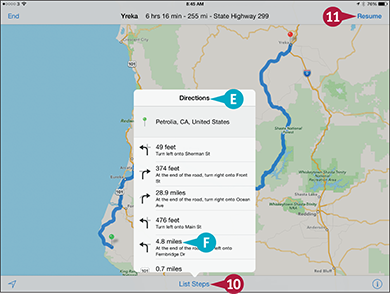
![]() Tap List Steps.
Tap List Steps.
E The Directions panel appears, showing a complete list of the directions.
F You can tap a direction to display it on the map.
![]() Tap Resume to return to step-by-step directions.
Tap Resume to return to step-by-step directions.
Explore with 3D Flyovers
Maps is not only great for finding out where you are and for getting directions to places, but also it can show you 3D flyovers of the places on the map.
After switching on the 3D feature, you can zoom in and out, pan around, and move backward and forward.
Explore with 3D Flyovers
![]() Press the Home button.
Press the Home button.
The Home screen appears.
![]() Tap Maps.
Tap Maps.
The Maps screen appears.

![]() Display the area of interest in the middle of the screen. For example, tap and drag the map, or search for the location you want.
Display the area of interest in the middle of the screen. For example, tap and drag the map, or search for the location you want.
![]() Tap
Tap ![]() .
.
The Map Options dialog opens.
![]() Tap Show 3D Map.
Tap Show 3D Map.
The screen switches to 3D view.

![]() Pinch out with two fingers to zoom in.
Pinch out with two fingers to zoom in.
Note: You can pinch in with two fingers to zoom out.
![]() Tap and drag to scroll the map.
Tap and drag to scroll the map.

![]() Place two fingers on the screen and twist clockwise or counterclockwise to rotate the view.
Place two fingers on the screen and twist clockwise or counterclockwise to rotate the view.
A The Compass arrow (![]() ) appears. The red arrow indicates north. You can tap this icon to restore the direction to north.
) appears. The red arrow indicates north. You can tap this icon to restore the direction to north.
Note: Pan and zoom as needed to explore the area.
![]() Tap and drag up with two fingers.
Tap and drag up with two fingers.
Note: Tap and drag down with two fingers to make the viewing angle steeper.
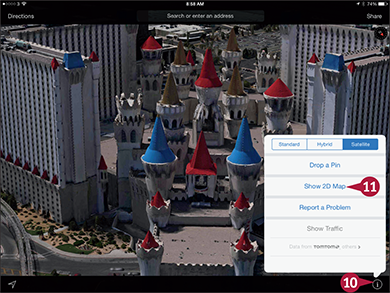
![]() Tap
Tap ![]() .
.
The Map Options dialog opens.
![]() Tap Show 2D Map.
Tap Show 2D Map.
The standard view reappears.
Use the Maps App’s Favorites and Contacts
When you want to return to a location easily in the Maps app, you can create a favorite for the location. Similarly, you can add a location to your contacts, so that you can access it either from the Contacts app or from the Maps app. You can either create a new contact or add the location to an existing contact. You can also return quickly to locations you have visited recently but not marked with a favorite or a contact.
Use the Maps App’s Favorites and Contacts
The Home screen appears.
![]() Tap Maps.
Tap Maps.
The Maps screen appears.

![]() Find the place for which you want to create a favorite. For example, tap and drag the map, or search for the location you want.
Find the place for which you want to create a favorite. For example, tap and drag the map, or search for the location you want.
![]() Tap and hold the place.
Tap and hold the place.
If the place has a map listing, Maps displays an information label. If not, Maps drops a pin on the place and displays a Dropped Pin label.
Note: To get rid of a pin you have dropped, tap the pin to display its pop-up label, and then tap the label. In the Location dialog that opens, tap Remove Pin.
![]() Tap
Tap ![]() on the label.
on the label.
The Location dialog opens.
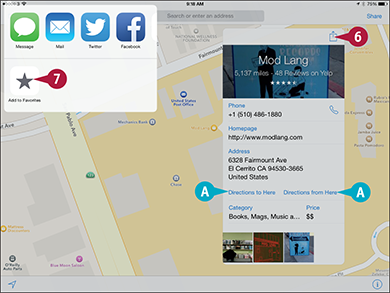
A You can quickly get directions to or from this location by tapping Directions to Here or Directions from Here.
![]() Tap Share (
Tap Share (![]() ).
).
The Share sheet opens.
![]() Tap Add to Favorites.
Tap Add to Favorites.
The Add to Favorites dialog opens.

![]() Type the name for the favorite. Alternatively, you can accept the default name, if there is one.
Type the name for the favorite. Alternatively, you can accept the default name, if there is one.
![]() Tap Save.
Tap Save.
The Add to Favorites dialog closes.
The Location dialog remains open.

![]() To create a new contact record for this location, tap Create New Contact. In the New Contact dialog that opens, type the details for the contact, and then tap Done.
To create a new contact record for this location, tap Create New Contact. In the New Contact dialog that opens, type the details for the contact, and then tap Done.
![]() To add this location to an existing contact record, tap Add to Existing Contact. On the Contacts screen that appears, tap the contact to which you want to add the location.
To add this location to an existing contact record, tap Add to Existing Contact. On the Contacts screen that appears, tap the contact to which you want to add the location.
Using the Clock App
The Clock app on your iPad provides four helpful time-keeping features. The World Clock feature enables you to keep track of the time easily in different cities; you can display a clock full screen to use your iPad as a timepiece. The Alarm feature lets you set as many alarms as you need, each with a different schedule and your choice of sound. The Stopwatch feature allows you to time events to the hundredth of a second. The Timer feature enables you to count down a set amount of time and play a sound when the timer ends.
Open the Clock App and Set Up the World Clock
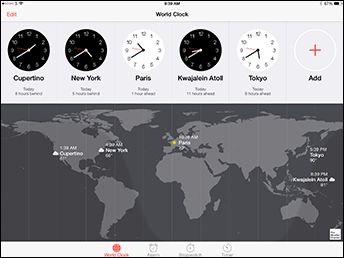
To open the Clock app, press the Home button and then tap Clock on the Home screen. The app displays the screen for the feature you last used. You can switch among the four features by tapping World Clock, Alarm, Stopwatch, or Timer at the bottom of the screen.
Tap World Clock at the bottom of the screen to display the World Clock screen. The World Clock shows a dark face for a clock where the local time is between 6:00PM and 5:59AM and a white face for a clock where the local time is between 6:00AM and 5:59PM.
To add cities, tap Add (![]() ) and then either type the start of the city name or simply browse the list. Tap the city you want to add, and it appears at the bottom of the list on the World Clock screen.
) and then either type the start of the city name or simply browse the list. Tap the city you want to add, and it appears at the bottom of the list on the World Clock screen.
You can edit the list of cities by tapping Edit. To remove a city, tap ![]() , and then tap Delete. To change the order, tap
, and then tap Delete. To change the order, tap ![]() and drag up or down. Tap Done when you finish editing.
and drag up or down. Tap Done when you finish editing.
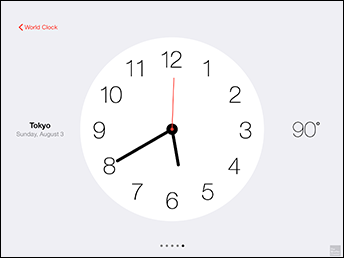
To display a clock full screen, tap World Clock and then tap the clock you want to show.
Swipe left or right or touch the dots at the bottom of the screen to change the clock displayed.
Tap World Clock when you want to return to the World Clock screen.
Set Alarms

Tap Alarm at the bottom of the screen to display the Alarm screen, which shows the current alarms with switches for enabling and disabling them.
Tap ![]() to start creating a new alarm. In the Add Alarm dialog, spin the dials to set the time. To create a repeating alarm, tap Repeat and then tap the days in the Repeat dialog. Tap Back to return to the Add Alarm dialog, then tap Label, type a descriptive name for the alarm, and tap Done. Tap Sound and choose the sound to play, and set the Snooze switch to On (
to start creating a new alarm. In the Add Alarm dialog, spin the dials to set the time. To create a repeating alarm, tap Repeat and then tap the days in the Repeat dialog. Tap Back to return to the Add Alarm dialog, then tap Label, type a descriptive name for the alarm, and tap Done. Tap Sound and choose the sound to play, and set the Snooze switch to On (![]() ) or Off (
) or Off (![]() ), as needed. Tap Save to save the alarm.
), as needed. Tap Save to save the alarm.
Time Events with the Stopwatch

Tap Stopwatch at the bottom of the screen to display the Stopwatch screen. You can then tap Start to start the stopwatch running.
If you need to mark lap times, tap Lap at the appropriate points. The elapsed lap times appear at the bottom of the screen. The current lap time appears below the main time readout.
Tap Stop to stop the stopwatch. You can then tap Start to restart the stopwatch or tap Reset to reset it so it is ready for its next use.
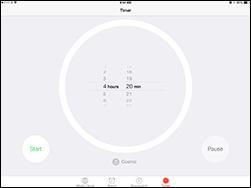
Tap Timer at the bottom of the screen to display the Timer screen. Spin the Hours dial and the Minutes dial to set the amount of time you want to count down. Tap the current sound name below the dials to display the When Timer Ends dialog, tap the sound you want to play or the Stop Playing action, and then tap Set. You can then tap Start to start the timer.
If you need to interrupt the timer, tap Cancel or Pause. Otherwise, when the timer sound plays, tap the prompt to stop it.
The Stop Playing action enables you to play music for a period of time and have it stop automatically — for example, to lull you to sleep.
Using Apple Pay
If your iPad is an iPad Air 2 or an iPad mini 3 or a later model, you can use Apple’s payment service to make payments online using your iPad. The iPad Air, iPad mini 2, and iPad mini do not have this capability, because it requires authentication using the Touch ID feature, which these models do not have.
Apple’s payment service is called Apple Pay. You can use it at a wide variety of online stores for convenience and security. If you have an iPhone 6 or iPhone 6 Plus, you can also use Apple Pay to make contactless payments at payment terminals.
Understanding How Apple Pay Works

The Apple Pay service links with the three major payment networks — Visa, MasterCard, and American Express — and enables you to use debit cards and credit cards issued on these networks by a wide variety of banks.
Apple Pay uses the Near Field Communications, or NFC, chip built into the iPhone 6 or iPhone 6 Plus to make contactless payments with card readers. On the iPhone, a chip called the Secure Element stores your payment information in an encrypted format for security.
At this writing, no iPad model has an NFC chip, so you cannot make contactless payments using an iPad. But on iPad models that include the Touch ID feature, you can use Apple Pay to make payments online quickly, easily, and securely.

Before you can make a payment with Apple Pay, you must set up your means of payment. To do so, you add the details of your debit card or credit card to your account on the iTunes Store. The easiest way to do this is to use iTunes on a Windows PC or on a Mac.
If you have already set up the debit card or credit card you want to use, you are ready to use Apple Pay on your iPad or other iOS device. Otherwise, open iTunes, click Store on the menu bar, and then click View Account to display the Account Information screen on the iTunes Store. Click Edit on the Payment Information line to display the Edit Payment Information screen. You can then enter the card details and click Continue or Done, depending on which button appears.
Make a Payment Online with Your iPad

After setting up Apple Pay, you can use it to make payments online using your iPad. You can make payments in various apps, including the Safari web browser. You can make payments to any retailer that accepts Apple Pay.
When an app displays a button with the Apple Pay logo on a payment screen, you can tap that button to use Apple Pay. On the subsequent screen, you use one of the fingers you have registered for Touch ID on the Home button to confirm the purchase and authenticate your identity.
Make a Payment at a Payment Terminal with an iPhone

If you have an iPhone 6 or iPhone 6 Plus, you can use Apple Pay to make payments easily at payment terminals located in retailers, cafés and restaurants, and places such as stations or airports.
To make a payment, you simply bring your iPhone up to the payment terminal, verify the amount displayed on-screen, and place one of the fingers you have registered with Touch ID on the Home button to approve the transaction and authenticate your identity.
Using iCloud Drive
iCloud Drive is online storage that enables you to store your files securely “in the cloud” — in other words, on the Internet — so that you can access them from anywhere. You can upload your files to iCloud Drive using your Mac and then access them using your iPad, your iPhone, or other devices.
Turn on iCloud Drive on Your Mac

Before you can use iCloud Drive on your Mac, you must turn it on. To do so, first click ![]() and System Preferences to open the System Preferences app, then click iCloud to display the iCloud pane.
and System Preferences to open the System Preferences app, then click iCloud to display the iCloud pane.
Click iCloud Drive (![]() changes to
changes to ![]() ) to enable iCloud Drive. Then click Options. The Options dialog opens.
) to enable iCloud Drive. Then click Options. The Options dialog opens.
Click Documents. The Documents tab appears.
Click each check box (![]() changes to
changes to ![]() , or
, or ![]() changes to
changes to ![]() ) to specify which apps may store documents and data in iCloud.
) to specify which apps may store documents and data in iCloud.
You can click Look Me Up By Email to display the Look Me Up by Email tab, and then choose which apps can look you up by your Apple ID.
Click Done to close the Options dialog. You can then click System Preferences on the menu bar and click Quit System Preferences to close the System Preferences app.
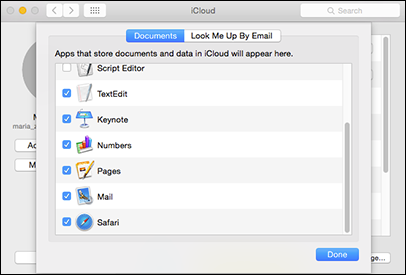
Put Files on iCloud Drive from Your Mac

If you have files on your Mac that you want to make available to yourself anywhere, so that you can access them from any Mac or PC or from your iPad or other iOS device, or other iOS device, upload them to iCloud Drive.
To upload files to iCloud Drive, you use the Finder. First, click open space on the Desktop to activate the Finder, and then press ![]() +
+![]() to open a new Finder window. Click iCloud Drive in the Favorites section of the sidebar to display the contents of iCloud Drive.
to open a new Finder window. Click iCloud Drive in the Favorites section of the sidebar to display the contents of iCloud Drive.
You can then create folders on iCloud Drive and copy files and folders to or from iCloud Drive using standard Finder techniques. For example, to create a new folder, ![]() +click, click New Folder on the context menu, type the name for the folder over the default name, and press
+click, click New Folder on the context menu, type the name for the folder over the default name, and press ![]() .
.
Access iCloud Drive on Your iPad

On your iPad, you access iCloud Drive through iCloud-enabled apps such as Apple’s apps Pages, Numbers, Keynote, iMovie, or GarageBand. Third-party apps designed for iCloud Drive, such as the scanning app Scanner Pro in the screen shown here, can also store files on iCloud Drive and open files from it.
Depending on the app you are using, you may see only some of the folders and files you have stored on iCloud Drive. For example, when you access iCloud Drive using Pages, you see only the contents of the Pages folder, the folder Pages automatically uses for storing your documents. You cannot use Pages to navigate to other folders, such as the Numbers folder, which is where the Numbers app stores your spreadsheet files.
